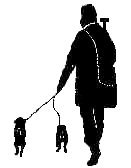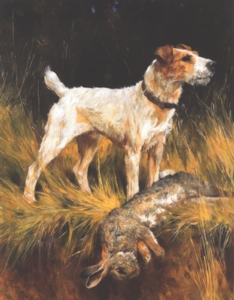| |
|
National Working
Terrier Federation
Report to the Committe of Inquiry into
Hunting with Dogs in England and Wales
(aka, "The Burns
Report")

Excerpts from the submission of the
National Working Terrier Federation to the
Hunting Inquiry or "Burns Report" on Hunting
with Dogs in the United Kingdom. The complete report can
be read at: http://www.huntinginquiry.gov.uk/evidence/terrier.htm#sec5
_____________________________________
- The
N.W.T.F. represents more practising terrier men
than any other organisation. Its membership
consists of a wide cross section of both
professional and voluntary pest controllers, game
keepers and hunt terrier men. It consists of 26
member terrier clubs and represents around
3000-4,000 individual members, plus
other affiliated organisations.
- N.W.T.F.
Member Terrier Clubs vary in size from small
local terrier clubs, to larger national
organisations such as the Fell and Moorland
Working Terrier Club (F.M.W.T.C.) and the Jack
Russell Terrier Club of Great Britain
(J.R.T.C.G.B.).
- The other
natural instinct of the working terrier, and a
characteristic which has been enhanced by
selective breeding, is that of barking at it's
quarry. Until very recently this was an essential
quality in any working terrier in that it was the
only means by which it could be located whilst
underground or in dense cover (i.e. prior to the
development and use of locating equipment).
- The terrier's
primary role is not to fight with it's
quarry. The role is to locate the quarry below
ground and to bark at it continuously, either
causing it to leave the earth, or alternatively
to indicate where in the earth the quarry is
located, in order that it can be dug to and
dispatched. Terriers are also used to locate and
flush quarry above ground and in dense cover.
- The standard
locating equipment operates up to a depth of
fifteen feet and this may be doubled with a
special adapter. This is ample, as the average
depth of a dig is around three feet. Today, It
would be most unusual to intentionally allow a
terrier to enter a fox earth unless wearing
locating equipment. It helps safeguard the
terrier and also ensures that the quarry is
quickly found and dispatched.
- The 1992
Badgers Act made it illegal to enter a terrier
into an active badger sett. These are a much
deeper and far more extensive range of tunnels
than a fox earth. As a result the earths which
are worked today are much smaller and less
complex than those in the past. Once again, this
means the quarry is more quickly and easily
located before being dispatched.
- So,
what is terrier work? What does it involve and
how is it carried out? First and foremost it is a
form of pest control. In fact it has many
similarities with that other well known and
widely practised form of pest control -
ferreting.
In both instances, it is a domestic animal
fitted with a locator collar which goes below
ground to locate and flush out another
mammal. In both instances, the quarry may not
always leave the earth and it may prove
necessary to dig down in order to retrieve
and dispatch it. In fact, the only real
difference is that one involves a ferret and
a rabbit, and the other a terrier and a fox.
How is it carried out? Let us consider the
typical scenario of a farmer who has been
losing chickens. One day, he notices fresh
chicken feathers in a hedge bottom. As he
gets closer he can see the feathers are
outside one of the entrance holes to an old
rabbit warren. He quietly approaches the
entrance by moving around the earth's
perimeter, not across it, avoiding any
unnecessary noise or vibrations. Upon closer
inspection, it is apparent that a couple of
the entrance holes have been slightly
enlarged. He carefully checks these and the
remainder of the warren for signs of badger
(as detailed in the Five Rules for the
Terrierman card - see Appendix V), but none
are present. He does however notice fox pad
marks in the sand outside one of the holes,
more feathers inside one of the other holes,
the distinctive odour of fox and a fox
dropping on a nearby mole hill. Confident
that the earth is now being used by a fox he
quickly returns home.
Once home, he collects his farmhand, terrier,
bag of purse nets, terrier locator, spade,
probe bar and gun. The terrier locator is
checked to ensure it is working correctly and
they drive back to the den, parking the
vehicle a short distance away. Once again,
they approach the den quietly, this time
placing a net over each of the entrance
holes. The farmer returns to his vehicle,
fits his terrier with it's locating collar
and takes both dog and gun back to the earth.
He allows the dog to quietly slip into the
larger entrance hole and stands back with his
gun. After a few minutes the terrier is heard
to be barking below ground. A few minutes
later there is a brown flash at one of the
other holes and a fox is bundled up alive as
the net quickly closes around it. The farmer
moves swiftly across the earth, quickly
inspects and identifies the quarry as a fox
(and not another animal) and dispatches it
immediately. The fox is removed and the net
replaced. A short while later the terrier
emerges from the same hole as the fox, shakes
the sand from its coat and excitedly wags his
tail at his master. The terrier is once again
allowed to enter the earth, but this time
from each of the remaining entrance holes.
Each time he passes straight through the
earth indicating there are no more foxes in
residence. The dog is checked for any signs
of injuries, none are present, and it and the
gun are returned to the vehicle. The nets are
removed and each of the entrance holes is
loosely filled with soil so that the farmer
can tell if the earth was being shared with
another fox, or if one decides to take up
residence at a later date. In a short time
both dog and master are back at the farmhouse
and a known poultry killer has been prevented
from causing further damage.
- Foxes are
lazy diggers, whilst they may occasionally dig
their own earths, they much prefer to enlarge a
rabbit burrow, or other hole, and take up
residence there. They also make use of man made
structures such as drains and hay bale stacks,
and frequent rock piles.
- For the
purpose of this report, the author surveyed a
cross section of hunt terrier men. The survey
included a gun pack, footpacks and mounted packs.
The regions covered were Wales, the Pennines, the
Midlands, the South of England and the West
Country. In most instances the findings were very
similar. These being that, once a terrier had
entered the earth, the majority of foxes would
chose to leave and this would normally be in ten
minutes or less. Where it was necessary to dig
down to the fox, the average depth was around
three foot and the average time taken
approximately thirty minutes or less.
- Wildlife
Network, an organisation known to be less than
sympathetic towards terrier work, in it's
literature ("Putting the Fox First")
poses the question "So why not ban
terrier work?" and goes on to state that
"/n an ideal world we would - but the
world is not
ideal and realism must guide us here."
......."Ban terrier work and hunting would
be seen by many farmers - the majority in some
areas - as next to useless as a form of fox
control. And that would lead to more shooting,
more snaring, greater cruelty and quite possibly
a higher annual death toll".

|
|
|

